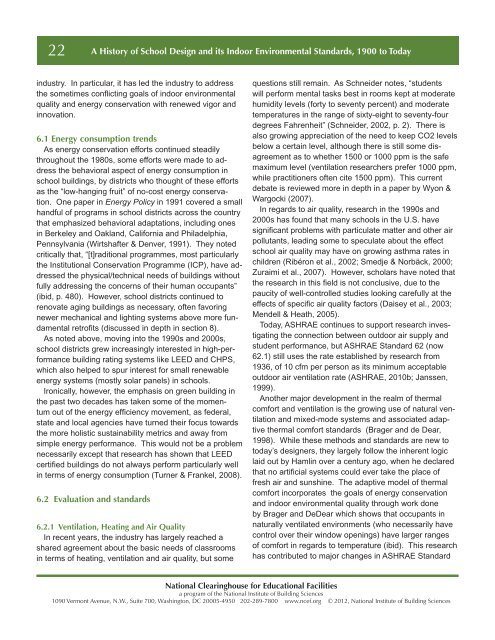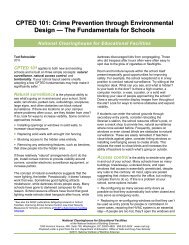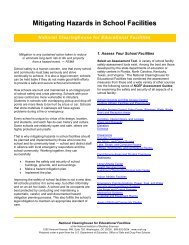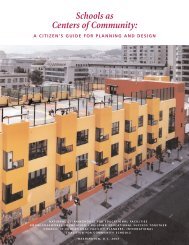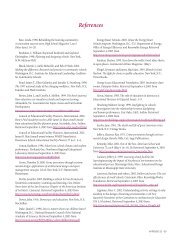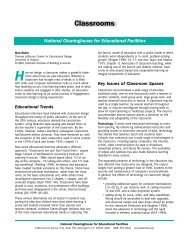A History of School Design and its Indoor - National Clearinghouse ...
A History of School Design and its Indoor - National Clearinghouse ...
A History of School Design and its Indoor - National Clearinghouse ...
Create successful ePaper yourself
Turn your PDF publications into a flip-book with our unique Google optimized e-Paper software.
22 A <strong>History</strong> <strong>of</strong> <strong>School</strong> <strong>Design</strong> <strong>and</strong> <strong>its</strong> <strong>Indoor</strong> Environmental St<strong>and</strong>ards, 1900 to Today<br />
industry. In particular, it has led the industry to address<br />
the sometimes confl icting goals <strong>of</strong> indoor environmental<br />
quality <strong>and</strong> energy conservation with renewed vigor <strong>and</strong><br />
innovation.<br />
6.1 Energy consumption trends<br />
As energy conservation efforts continued steadily<br />
throughout the 1980s, some efforts were made to address<br />
the behavioral aspect <strong>of</strong> energy consumption in<br />
school buildings, by districts who thought <strong>of</strong> these efforts<br />
as the “low-hanging fruit” <strong>of</strong> no-cost energy conservation.<br />
One paper in Energy Policy in 1991 covered a small<br />
h<strong>and</strong>ful <strong>of</strong> programs in school districts across the country<br />
that emphasized behavioral adaptations, including ones<br />
in Berkeley <strong>and</strong> Oakl<strong>and</strong>, California <strong>and</strong> Philadelphia,<br />
Pennsylvania (Wirtshafter & Denver, 1991). They noted<br />
critically that, “[t]raditional programmes, most particularly<br />
the Institutional Conservation Programme (ICP), have addressed<br />
the physical/technical needs <strong>of</strong> buildings without<br />
fully addressing the concerns <strong>of</strong> their human occupants”<br />
(ibid, p. 480). However, school districts continued to<br />
renovate aging buildings as necessary, <strong>of</strong>ten favoring<br />
newer mechanical <strong>and</strong> lighting systems above more fundamental<br />
retr<strong>of</strong>i ts (discussed in depth in section 8).<br />
As noted above, moving into the 1990s <strong>and</strong> 2000s,<br />
school districts grew increasingly interested in high-performance<br />
building rating systems like LEED <strong>and</strong> CHPS,<br />
which also helped to spur interest for small renewable<br />
energy systems (mostly solar panels) in schools.<br />
Ironically, however, the emphasis on green building in<br />
the past two decades has taken some <strong>of</strong> the momentum<br />
out <strong>of</strong> the energy effi ciency movement, as federal,<br />
state <strong>and</strong> local agencies have turned their focus towards<br />
the more holistic sustainability metrics <strong>and</strong> away from<br />
simple energy performance. This would not be a problem<br />
necessarily except that research has shown that LEED<br />
certifi ed buildings do not always perform particularly well<br />
in terms <strong>of</strong> energy consumption (Turner & Frankel, 2008).<br />
6.2 Evaluation <strong>and</strong> st<strong>and</strong>ards<br />
6.2.1 Ventilation, Heating <strong>and</strong> Air Quality<br />
In recent years, the industry has largely reached a<br />
shared agreement about the basic needs <strong>of</strong> classrooms<br />
in terms <strong>of</strong> heating, ventilation <strong>and</strong> air quality, but some<br />
questions still remain. As Schneider notes, “students<br />
will perform mental tasks best in rooms kept at moderate<br />
humidity levels (forty to seventy percent) <strong>and</strong> moderate<br />
temperatures in the range <strong>of</strong> sixty-eight to seventy-four<br />
degrees Fahrenheit” (Schneider, 2002, p. 2). There is<br />
also growing appreciation <strong>of</strong> the need to keep CO2 levels<br />
below a certain level, although there is still some disagreement<br />
as to whether 1500 or 1000 ppm is the safe<br />
maximum level (ventilation researchers prefer 1000 ppm,<br />
while practitioners <strong>of</strong>ten cite 1500 ppm). This current<br />
debate is reviewed more in depth in a paper by Wyon &<br />
Wargocki (2007).<br />
In regards to air quality, research in the 1990s <strong>and</strong><br />
2000s has found that many schools in the U.S. have<br />
signifi cant problems with particulate matter <strong>and</strong> other air<br />
pollutants, leading some to speculate about the effect<br />
school air quality may have on growing asthma rates in<br />
children (Ribéron et al., 2002; Smedje & Norbäck, 2000;<br />
Zuraimi et al., 2007). However, scholars have noted that<br />
the research in this fi eld is not conclusive, due to the<br />
paucity <strong>of</strong> well-controlled studies looking carefully at the<br />
effects <strong>of</strong> specifi c air quality factors (Daisey et al., 2003;<br />
Mendell & Heath, 2005).<br />
Today, ASHRAE continues to support research investigating<br />
the connection between outdoor air supply <strong>and</strong><br />
student performance, but ASHRAE St<strong>and</strong>ard 62 (now<br />
62.1) still uses the rate established by research from<br />
1936, <strong>of</strong> 10 cfm per person as <strong>its</strong> minimum acceptable<br />
outdoor air ventilation rate (ASHRAE, 2010b; Janssen,<br />
1999).<br />
Another major development in the realm <strong>of</strong> thermal<br />
comfort <strong>and</strong> ventilation is the growing use <strong>of</strong> natural ventilation<br />
<strong>and</strong> mixed-mode systems <strong>and</strong> associated adaptive<br />
thermal comfort st<strong>and</strong>ards (Brager <strong>and</strong> de Dear,<br />
1998). While these methods <strong>and</strong> st<strong>and</strong>ards are new to<br />
today’s designers, they largely follow the inherent logic<br />
laid out by Hamlin over a century ago, when he declared<br />
that no artifi cial systems could ever take the place <strong>of</strong><br />
fresh air <strong>and</strong> sunshine. The adaptive model <strong>of</strong> thermal<br />
comfort incorporates the goals <strong>of</strong> energy conservation<br />
<strong>and</strong> indoor environmental quality through work done<br />
by Brager <strong>and</strong> DeDear which shows that occupants in<br />
naturally ventilated environments (who necessarily have<br />
control over their window openings) have larger ranges<br />
<strong>of</strong> comfort in regards to temperature (ibid). This research<br />
has contributed to major changes in ASHRAE St<strong>and</strong>ard<br />
<strong>National</strong> <strong>Clearinghouse</strong> for Educational Facilities<br />
a program <strong>of</strong> the <strong>National</strong> Institute <strong>of</strong> Building Sciences<br />
1090 Vermont Avenue, N.W., Suite 700, Washington, DC 20005-4950 202-289-7800 www.ncef.org © 2012, <strong>National</strong> Institute <strong>of</strong> Building Sciences


